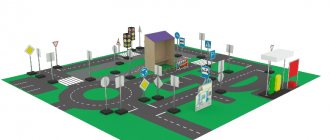Traffic lights and traffic controller signals
Traffic light
cancels the actions of priority signs, but does not cancel the indication of signs prescribing the direction of movement, and
the traffic controller
can cancel the instructions of the traffic light, any road signs and markings, but do not forget that traffic on the lanes must comply with
the Rules for driving through intersections
.
If there is no traffic light or traffic controller, look at the signs or markings
.
Signs are more important than markings, and a temporary sign is more important than a permanent sign.
Read more here
General provisions
First of all, it is enough to know that in Russia there is right-hand traffic and you can only move on the extreme right side of the road, and use your eye to determine the width of the roadway. The first step is to divide the road
in half and know your lane for traffic; the lane width according to GOST should be from 2.5 to 4 meters. The right of way for traffic is given to those who have their own lane free or are on the main road.
Read more here
Driving through intersections
If you have practical driving
relatively normal, you just have to be careful not to interfere with those moving on the right, because they always have the advantage. The “right hand” advantage operates where there are no traffic lights, signs, markings, or other indicators that directly regulate traffic.
When approaching an intersection, look at the signs and be prepared to change lanes in advance. It is advisable to choose the route in advance.
When turning left, give way to oncoming people. Always and everywhere give way to pedestrians.
Read more here
Overtaking, oncoming traffic
Overtaking is considered to be the advance of one or more vehicles into the oncoming lane .
Advancing traffic within the carriageway of the same direction is not considered overtaking.
Before overtaking, the driver must be 100% sure that the maneuver is safe. This requires both experience and cold calculation. It’s better not to take risks if the speed is already more than 80 km/h and you have less than 5 years of experience.
Read more here
Start of movement, maneuvering
The beginning of movement is the beginning of beginnings.
This topic in the exam papers covers more than three questions in one paper.
The first rule - before the first trip on the road, a novice driver must confidently master all the controls of the car -
to press the brake or gas pedal in time.
Know that it is necessary to turn on the direction indicators in advance when performing a maneuver, and turn them off immediately after its completion.
When entering the road from adjacent areas, give way to everyone who crosses your path.
Turning is carried out only from the leftmost lane; exceptions may only be for long road trains or narrow roadways.
Read more here
.
Travel speed
Next, you need to be able to maintain the speed of your car corresponding to the speed of traffic on the road, and when moving slowly, not interfere with other road users, for which you can also get a fine. To join the flow you must be ready for it.
If you are afraid and cannot move at the set speed, or for any other reason, simply turn on the hazard lights, look in the rearview mirror and gradually begin to move to the right, and stop on the side of the road, or as far to the right as possible to the edge of the roadway, put up a warning triangle at a distance of at least 15 meters behind your car. If you are on a turn, the distance from your car to the sign must be at least 30 meters.
Permissible speed according to the Rules:
- In residential and courtyard areas no more than 20 km/h
- On roads in populated areas no more than 60 km/h
- Outside the populated area no more than 90 km/h ( there are restrictions for various vehicles)
- On the Motorway no more than 110 km/h and no less than 40 km/h (there are restrictions for various vehicles)
More details here






